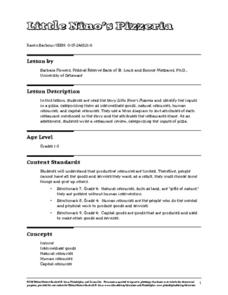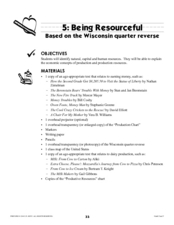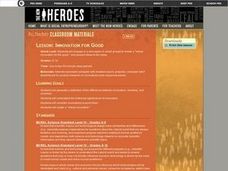Carolina K-12
Factors of Production and Economic Decision-Making
Class members begin this engaging economics activity by listing all the resources used in producing a car and using that example to draw parallels to the four primary factors of production: capital goods, labor, natural resources, and...
Curated OER
Lemonade For Sale
2-3rd graders listen to the story, Lemonade for Sale, by Stuart J. Murphy. In the story, children produce and sell lemonade to raise money for their clubhouse, create a product, classify the resources used in production as natural...
Center for Entrepreneurship and Economic Education
Popcorn Economics
Scarcity of resources is a fundamental economics concepts that kids need to understand. You'll use a large bag of popcorn to demonstrate this concept. Have the class come up row-by-row to fill their snack bags with popcorn. By the last...
Curated OER
Is Capitalism Good for the Poor?
Students have the unique opportunity to analyze actual data collected by field researchers They research to see whether holding clear title made a difference in farmers' willingness to invest in capital improvements that would increase...
Curated OER
Capital for Cookies
Fourth graders find the meaning for capital, land, labor and enterprise and relate them to economics of a place. In this economics lesson, 4th graders form a company to make an agricultural product and look for the resources they will...
Federal Reserve Bank
Little Nino's Pizzeria
Engage your youngsters in basic economics by connecting the terms to dessert and pizza! After a discussion about intermediate goods and natural resources, learners read and connect a pizzeria to economic terms.
Curated OER
Chapter 2: The Economizing Problem
It doesn't take a lecture on economics to convince teenagers that one's wants often exceed one's means, but this presentation will hopefully help them to understand the discrepancy. Using an example of pizza and robot arms, the slides...
Curated OER
Being Resourceful: Wisconsin quarter reverse
If your class understands goods and services then they'll be ready for this lesson on various resources. After reading a series of books and engaging in class lecture and discussion, pupils will fill out worksheets. They will list...
Federal Reserve Bank
Messy Bessey's Holidays
Teach your class some fairly complex terms—factors of production, human resources, capital resources, natural resources, and intermediate goods—with a storybook (Messy Bessey's Holidays), plenty of visuals and handouts, and related...
Federal Reserve Bank
Ten Mile Day
Get your class working on the railroad with this detailed and interactive lesson. After reading and discussing Ten Mile Day, learners explore division of labor, human capital, and productivity with a hands-on group activity in which they...
Curated OER
Will the Real Capitalism Please Stand Up?
Students analyze descriptions from five different countries to determine which institutional components of capitalism are present and, if so, to what extent. They then place each on a continuum depending upon the number and strength of...
Curated OER
Three Little Pigs: Human, Natural and Capital Resources
First and second graders will learn about natural, capital , and human resources through the story The Three Little Pigs. They will listen to the story, write down what they know about straw, wood, and brick, then complete a chart...
Curated OER
My Side of the Mountain
Learners complete activities with the book My Side of the Mountain by Jean Craighead George. In this literature lesson plan, students read the book and discuss the concept of human capital. They complete a KWLH chart and two assessments.
Federal Reserve Bank
Wants on a Continuum
You can't always get what you want, but you might just be able to teach your class about wants and choices. This plan leads pupils through a discussion and closes with a worksheet and assessment.
Curated OER
The Goat in the Rug
Students define productive, capital, human and natural resources and intermediate goods, then classify these things by how they are used in a production process. In this resources/goods lesson plan, students listen to the story The Goat...
Curated OER
Popcorn Economics
Young scholars examine the concept of scarcity. For this economics lesson, students define scarcity and take part in an activity that illustrates the concept as it relates to goods and services.
Curated OER
Innovation for Good
Many historical innovations were created for the common good. Get your students ready for life as a critical thinker with this lesson which defines the differences between innovation and invention. They will conduct Internet research,...
Curated OER
Tortilla Factory
Students identify productive resources and intermediate goods used to produce corn tortillas. In this productive resources lesson, students listen to the book Tortilla Factory and classify resources used to make paper tacos.
Curated OER
The Basic Questions: What, How, and For Whom?
Students review the various types of economic systems. As a class, they identify the three basic economic questions: what?, How?, and For Whom?. Using capitalism as an economic system, they discuss how each question is answered.
Curated OER
How Resourceful Are You?
Pupils investigate the concept of resources. They differentiate between natural, human, and capital resources. Prior to the lesson the students need to build background knowledge of goods, services, needs, and wants. They create a...
Curated OER
Is Capitalism Good for the Poor? | How Incentives Affect Innovation
Learners focus on the role played by a nation's institutions in generating creativity, invention and innovation, and analyzes how innovation promotes the economic growth that raises standards of living and alleviates poverty.
Curated OER
Keeping Up With Capitals
Students engage in a class discussion where they identify the situations where capitalization is necessary. They complete worksheets embedded in the plan where they capitalize proper nouns such as names, holidays, and special events...
Curated OER
The Soviet Choice For Growth
Young scholars examine five major events in Soviet History to introduce the concept of opportunity cost. They identify considered alternatives at the time of decision and examine benefits and cost. They apply these ideas to a typical...
Curated OER
Is Capitalism Good for the Poor? | No More Slide Rules – The Costs and Benefits of Innovation
Young scholars brainstorm a list of the benefits that Americans at all levels of society have enjoyed as a result of innovations in rail transportation/computers/microprocessors. They write a response from President Jackson to Martin Van...
Other popular searches
- Land Labor Capital Goods
- Capital Goods in Economics
- Consumer and Capital Goods
- Gdp and Capital Goods

























